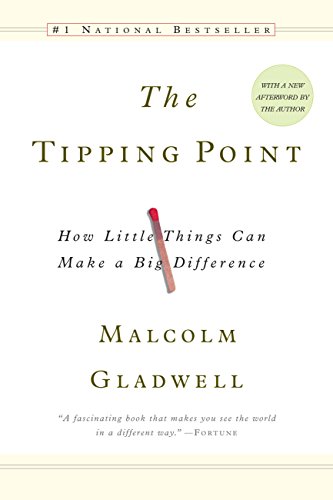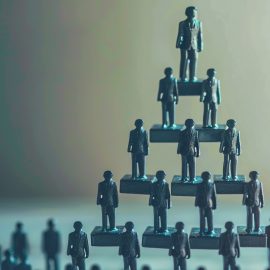

This article is an excerpt from the Shortform summary of "The Tipping Point" by Malcolm Gladwell. Shortform has the world's best summaries of books you should be reading.
Like this article? Sign up for a free trial here .
What is the Law of the Few? Where does it come from? Why is it important in business, sales, and marketing?
The Law of the Few is the idea that certain types of people are especially effective at spreading an infectious idea, product, or behavior. This idea was popularized in Malcolm Gladwell’s book The Tipping Point.
We’ll cover examples of the Law of the Few and look at why the messengers matter in the art of marketing.
The Law of the Few
There are three factors that can be adjusted to turn an idea into a social epidemic: the messenger (the law of the few), the message itself (the stickiness factor), or the context of the message (the power of context).
The Law of the Few: Certain types of people are especially effective at spreading an infectious idea, product, or behavior.
Use the Right Messengers
When you’re trying to spread a message, idea, or product to epidemic proportions, you can’t do it all yourself; you need people to help preach your message and spread the word to the masses. But not just anyone will do. The Law of the Few proposes that there are certain, special types of people who are much more effective at broadcasting your idea and getting people to listen and follow suit in order to create an epidemic.
These special people fall into three personality types that make them exceptional either in their social connections, knowledge, or persuasiveness.
Patient Zero of AIDS is an example of the power of key players in the spread of epidemics. This so-called Patient Zero was Gaetan Dugas, who falls into the category of being particularly well connected. Dugas was a French-Canadian flight attendant who reportedly had 2,500 sexual partners across North America. Dugas is linked to at least 40 of the first cases of AIDS in California and New York.
The Law of the Few is a more extreme version of the 80/20 Principle in economics, which dictates that in a given situation, about 20 percent of participants will be responsible for 80 percent of the “work.” For example, 20 percent of drivers cause 80 percent of all traffic accidents. And in many societies, 20 percent of criminals are responsible for 80 percent of crimes.
The Law of the Few, or The Messenger Matters
The Law of the Few is about the people who spread messages, ideas, or viruses and cause epidemics to tip. These are specific types of people who have the contacts, knowledge, and social skills to effectively spread an idea far and wide.
Connectors: People With Strong Social Networks
The idea of “connectors” is important to understanding the Law of the Few. Connectors are people who seem to know everyone. You can find Connectors in every walk of life. Connectors are sociable, gregarious, and are naturally skilled at making — and keeping in contact with — friends and acquaintances.
Six Degrees of Separation and the Law of the Few
In the 1960s, psychologist Stanley Milgram conducted the “small-world experiment” to research how closely people are connected. He sent letters to 160 people in Nebraska, giving them the name and address of a stockbroker in Boston and instructing them to write their name on the letter and then send it to a friend or acquaintance who might get the letter one step closer to that stockbroker. Each person who received the chain letter would do the same, until a friend or acquaintance of the stockbroker finally received it and would send it directly to him.
At the end of the experiment, Milgram found that most of the letters reached the stockbroker in five or six steps, creating the concept that people all over the world are all connected by six degrees of separation.
Even further, Milgram discovered that half of the letters were ultimately delivered to the stockbroker by three people. Although everyone is linked by just six degrees of separation, a small group of people are connected to a disproportionately large number of people. Those few, well-connected people are the Connectors.
(Shortform note: The notion that a handful of powerful people can spread a message further and more effectively than the rest of the population is called the Influentials theory, and has been a staple in marketing for 50 years. However, several more recent experiments by network-theory scientist Duncan Watts determine that these rare trendsetters — or hubs, in his experiment — are no more influential in spreading an idea than the rest of the population. Watts recreated Milgram’s small-world experiment with email and found that only 5 percent of messages passed through Connectors. Additionally, Watts has found that the public’s mood and susceptibility to influence at a given time is a far greater determinant of whether an epidemic tips than the strength of the influencer spreading the idea.)
Mavens: People Who Are Always in the Know
While Connectors are people specialists, Mavens are information specialists. They also contribute to the Law of the Few. They are the kinds of people who are endlessly curious and adept at gathering and retaining information on a wide variety of (sometimes obscure) topics.
In a marketing and retail context, these people are called “Market Mavens” or “price vigilantes.” They watch price fluctuations, know when stores are having sales, collect coupons, and know the days when the coupons are worth double.
Mavens not only collect information, but they also enthusiastically share their knowledge with other people. They are socially motivated to help people with the information they’ve gathered; a Maven may give you some of her coupons, and remind you when a sale is coming up. Mavens have no ulterior motive for sharing information; they just want to help. Their genuine helpfulness inspires more trust and credibility, so when they give recommendations people tend to take them more seriously.
Whereas a Connector’s influence lies in knowing many people and spreading information widely, a Maven’s influence is in the power of her recommendation. People know that Mavens are knowledgeable and trustworthy sources of information, so a Maven’s word carries a lot of weight. If a Maven suggests you check out a budding epidemic, you’re inclined to listen.
- For example, a Connector might recommend a restaurant to 10 people, and five of them take her advice and try out the restaurant. A Maven might recommend a restaurant to five people, and all of them try it out, because they know that she always has reliable information about the hottest restaurants and best-kept secrets.
Mavens are both teachers and students: They love to learn new information as much as they love to share it. In this way, Mavens mine their social contacts for tips and recommendations, while also doling out their own advice. In a social epidemic, Mavens serve as data banks — they carry the message, with authoritativeness.
Salesmen: The Great Persuaders
Salesmen are the people who pitch the idea or message behind an epidemic and persuade people to jump on board. They do not merely store and share information; Salesmen want to convince you to follow their advice. Behavioral psychologist Donald Moine has widely studied persuasion, and says that a great salesman is armed with more and better responses to potential clients’ objections. Salesmen contribute to the Law of the Few.
Salesmen have all the right words as well as a distinct energy, enthusiasm, charm, and likability that makes people want to listen to them. But there’s something more: Salesmen instinctively know how to use nonverbal cues to reinforce their power of persuasion.
Nonverbal communication includes hand gestures, facial expressions, tone of voice, eye contact, posture, cadence of speech, and body language. Nonverbal cues have a powerful impact on us, even when they are so subtle that we don’t notice them.
Salesmen Are Experts At Nonverbal Harmony
Everyone engages in nonverbal communication, and the nonverbal messages you send reveal whether you agree or disagree with someone, if you’re making an effort to connect with them, or if you are totally disinterested.
When people talk, research shows that they subconsciously synchronize their movements and gestures with each other almost immediately. They quickly match each other’s volume, pitch, and speaking rhythm. Salesmen are especially adept at drawing people into their own conversational rhythms, allowing them to set the tone for the interaction.
In addition to conversational harmonizing, people imitate each other’s emotional expressions. This is called motor mimicry: If someone frowns, you are likely to frown as an automatic response. What’s more, physical expressions influence your actual emotions, so through motor mimicry, you can have a strong influence on others’ emotions.
In this way, emotions are contagious. For example, if someone you’re talking to is happy about something, she’d smile as she talks to you. In automatic response, you smile back. Subconsciously, this smile brings you some happiness.
You feel more interested and enthralled with people with whom you have a high level of synchrony. Salesmen effortlessly pull you into harmony with them. Their uncanny ability to draw people into their conversational rhythms and emotional expressions make Salesmen particularly skillful at influencing people’s emotions. And that is a very powerful tool of persuasion.
Case Study: Paul Revere’s Midnight Ride
In April of 1775, a silversmith named Paul Revere rode his horse through the towns surrounding Boston in the middle of the night, spreading the news that he expected the British to attack the next morning and mobilizing locals to act. He was so effective that the colonial militia beat the British that following morning, in a battle that sparked the American Revolution. Revere helped spread the news throughout the entire region in a matter of hours, making his midnight ride one of the most famous historical examples of a word-of-mouth epidemic. This is a great example of the Law of the Few.
That same night, a fellow Bostonian named William Dawes took a midnight ride in the opposite direction as Revere to help spread the message, but hardly anyone mobilized in the towns he rode through. What made Revere so much more successful than Dawes?
First, Revere was a Connector. He was not only social and gregarious, but also a fisherman, hunter, cardplayer, theater-goer, businessman, and a member of the Masonic Lodge and several social clubs and community organizations; he was part of many different social circles in the Boston area. When he made his midnight ride, Revere was so well-connected that he knew who to alert — the local militia leaders and key figures in the community — to make the biggest impact.
Dawes, by contrast, likely had an average social circle, and his connections were probably much weaker in the area outside of Boston, where he was trying to spread the news. When he knocked on doors that night, he didn’t know whether he was at the home of a local leader or a farmer who had little power to further spread the message.
Second, Revere was a Maven. He was involved in a community group that actively collected information on the activities of British troops. He had warned local militia before about British schemes he had learned of. People knew that Revere was a reputable source of information about the British troops, so when they heard his warning on the night of his midnight ride, it carried more weight.
The Law of the Few and the Role of Permission-Givers
The Law of the Few undoubtedly played a part in tipping the teen smoking epidemic. Teen smoking is a prime example of how Salesmen can make a behavior contagious by playing the role (sometimes inadvertently) of permission-givers for something as harmful as smoking. In spite of anti-smoking messaging insisting that the habit is unattractive and uncool, many people have deep-seated associations of cigarettes with sophistication. Often, people think of a smoker from their childhood who exuded a sort of carefree coolness. Knowingly or not, those smokers become permission-givers.
The archetype of smokers as cool rebels is actually no coincidence, as research shows that there are common personality traits among smokers that include extroversion, sociability, sexual precocity, impulsivity, risk-taking, defiance, and indifference to the opinions of others. Many of these are the kinds of traits that make a person seem impossibly cool, especially to teenagers.
Smokers aren’t cool because they smoke, but rather smoke because they are cool; the traits that make these teens prone to smoking happen to be the same traits that make them seem cool to peers. But no matter the reasoning, the association — and its power to influence others to smoke — remains the same. People’s memories of sophisticated family members, older friends, or celebrities (permission-givers) smoking make them want to emulate their cool by taking up the habit as well, overpowering health information and logical self-preservation. This is the negative side of the Law of the Few.
———End of Preview———

Like what you just read? Read the rest of the world's best summary of "The Tipping Point" at Shortform . Learn the book's critical concepts in 20 minutes or less .
Here's what you'll find in our full Tipping Point summary :
- What makes some movements tip into social epidemics
- The 3 key types of people you need on your side
- How to cause tipping points in business and life






